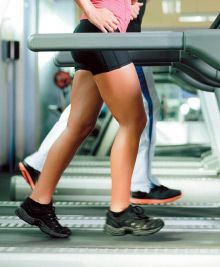When sports chiropractors first appeared at the Olympic Games in the 1980s, it was alongside individual athletes who had experienced the benefits of chiropractic care in their training and recovery processes at home. Fast forward to Paris 2024, where chiropractic care was available in the polyclinic for all athletes, and the attitude has now evolved to recognize that “every athlete deserves access to sports chiropractic."
Steps to Successful Rehabilitation, Part 3
If a doctor is already using aerobic rehabilitation exercise in practice or is planning to, there are specific procedures that must be followed in order to develop the most productive program for any patient. These procedures also hold true when developing training programs for healthy patients. Four steps in particular are necessary when formulating a plan for aerobic exercise for the heart and lungs. Following these steps in order will assure that all bases are covered with each care plan.
1. Exercise Mode
The type of aerobic exercise employed is the mode of exercise. Walking, running, riding a stationary or road bike, elliptical trainer, or stair-step machine, swimming, and performing many other exercises are possibilities. The choice of which to use is based on what equipment is available, the expense involved, the physical condition of the patient and the patient's commitment to participation.
The easiest form of aerobic exercise is walking. It does not require a membership and cost is limited to a good pair of shoes and flexible, custom-made orthotics for proper support. It can be performed indoors or out and does not require a great deal of athletic ability. The benefits of walking are numerous. Weight reduction, improved heart and lung health, stress relief, improved bone density and lower rates of injury are among the attributes associated with walking for exercise.
2. Training Frequency

The number of times exercise is performed per week is the training frequency. The frequency may be low at first and build as the patient's health improves. As a general rule, three sessions per week is the minimum number needed to produce noticeable results. Frequency can increase up to seven sessions per week depending upon the intensity of exercise mode chosen.
3. Exercise Duration
The number of minutes performed and/or distance traveled during aerobic exercise is termed the exercise duration. Treadmills, stationary bikes and other machines allow the patient to track one or both of these factors. In the absence of a monitor to measure distance, time can be used as the benchmark, as measured by a watch. Duration should not fall below 10 minutes. Optimal time is 20 minutes or more.
4. Training Intensity
The amount of exertion or stress placed on the body is the training intensity. A patient may be performing all three of the above steps, but if they are not performing them with enough intensity, the patient will derive little benefit. For exercise to be beneficial, the intensity of the exercise must go beyond the intensity experienced during normal daily activities.
Many patients will make statements like, "I walk in the factory all day at work. I don't need to walk for exercise." While walking all day is better than sitting all day, it is not exercise if it is what the patient does every day. The walking may not be fast enough to evoke the physical response necessary for training and improving the body. The daily activities also likely involve many stops and starts that prevent the duration of the activity from being continuous enough to be beneficial. The intensity must stress the body above the patient's normal activities, but not to the point of detriment or injury.
Monitoring Training Intensity: As a general rule of thumb, if the patient is not sweating after 10 minutes of exercise, they are not achieving the minimal amount of intensity needed to improve health. On the opposite side of the coin, if the patient cannot carry on a conversation while exercising, then intensity is too high.
| 15-Pt. Borg Perceived Exertion Scale | Rating |
| No exertion at all | 6 |
| Extremely Light | 7-8 |
| Very Light | 9-10 |
| Light | 11-12 |
| Somewhat Hard | 13-14 |
| Hard (heavy) | 15-16 |
| Very Hard | 17-18 |
| Extremely Hard | 19 |
| Maximal Exertion | 20 |
Rating Perceived Exertion: The 15-point Borg scale (see table) is often used to rate perceived exertion. The scale is a little harder for patients to use. The doctor may wish to use the Borg scale for in-office assessment and have the patient use the methods listed above at home.
Exercise Velocity (Pace): Intensity can also be monitored by tracking the velocity (speed) at which the exercise is performed. Obviously the higher the velocity, the higher the intensity of the exercise. Velocity must be taken into consideration with the other methods of measurements of intensity.
Beginning a walking program is recommended early (within two weeks) after injury, especially spinal injury. This will help the healing process and speed recovery of the patient. Early professional care and developing an aerobic fitness base will aid in the transition to the next phase of rehabilitation, strength training, to be discussed in part 4 of this series.
Resources
- Baechle T, Earle R. Essentials of Strength and Conditioning, Second Edition. Human Kinetics, 2000.
- Cotton R, Ekeroth C. Personal Trainer Manual: The Resource for Fitness Professionals. American Council on Exercise, 1997.
- Deuster P. The Navy SEAL Physical Fitness Guide. Department of Military and Emergency Medicine, Uniformed Services University of the Health Sciences F. Edward Hebert School of Medicine, August 1997.
- Siff M. Facts and Fallacies of Fitness,4th Edition. Self published, 2000.
This is part 3 of a four-part series on rehabilitation. Part 1 appeared in the Jan. 1 issue; part 2 ran in the Feb. 12 issue.


